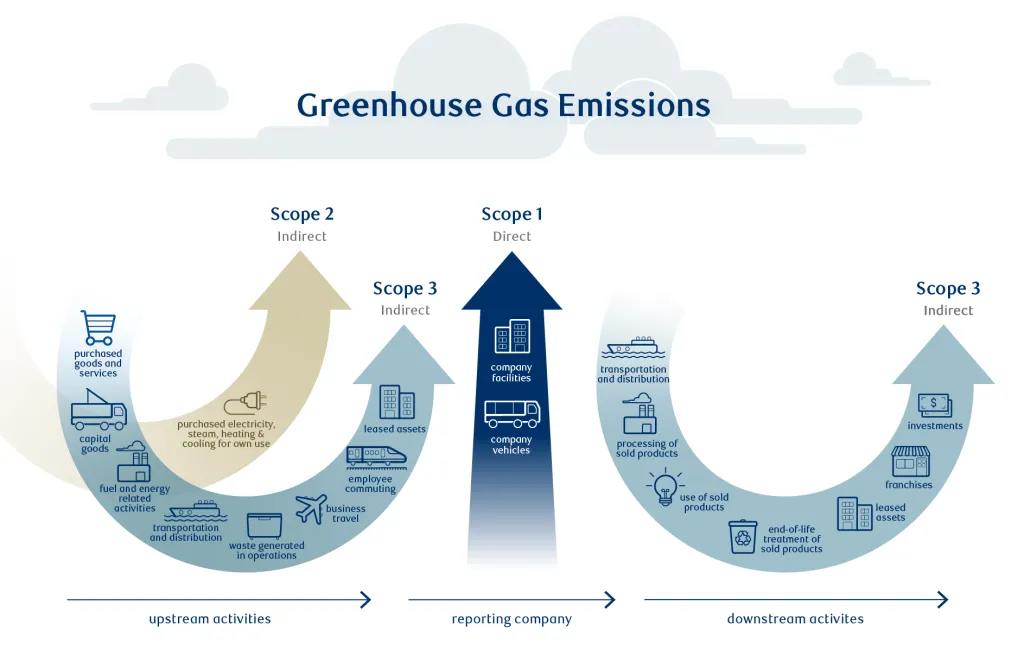TLDR
-
To begin reducing your environmental impact, it can be helpful to understand the concept of Scope 1, 2, and 3 emissions, which categorize greenhouse gas emissions and provide a framework for tracking and reducing emissions from your business.
-
Scope 1 refers to emissions produced directly by a company’s day-to-day operations, and can be reduced through actions like transitioning to electric fleets or energy-efficient building upgrades.
-
Scope 2 are indirect emissions associated with the purchase of energy, and can be reduced by switching to renewable energy sources, investing in on-site energy systems, or upgrading to energy-efficient equipment.
-
Scope 3 are indirect emissions that occur across the entire value chain, including upstream activities and downstream activities.
So, you‘re interested in reducing your environmental impact, but don’t know where to start? That’s an issue many businesses face, in part because of the seemingly complicated ways emissions are tracked and categorized. While there’s certainly plenty of lingo to learn on your decarbonization journey—a term that refers to reducing, and potentially eliminating, carbon dioxide and other greenhouse gas (GHG) emissions from your business—one way to start is by understanding what are called Scope 1, 2 and 3 emissions.
Since there are many actions organizations can take to reduce their GHG emissions, businesses might consider following industry standards around classifying emissions. In the early 2000s, a framework around “scopes,” was developed by the World Resources Institute (WRI) and the World Business Council for Sustainable Development (WBCSD) to help companies better identify and measure their emissions sources. Here’s what to know about each.
Scope 1: Sources in your control
The first emissions category is often the most straightforward: It covers any GHGs produced directly by your business. That could be the fuel burned by your vehicles, emissions produced by manufacturing or industrial processes, leaks in air conditioning systems and more.
Here’s another way to put it: These are the emissions produced by a company’s day-to-day operations.
How to reduce Scope 1 emissions
Scope 1 could be one of the first places you would go when looking for ways to decarbonize because they would be within your control. That doesn’t mean reducing your company’s emissions will be easy, but transitioning, say, your combustion engine cars and trucks to an all-electric fleet is something many businesses could consider. Other ways to lower Scope 1 emissions include pursuing energy-efficient building upgrades or finding ways to reduce waste in your manufacturing processes.
It’s also important to get employees involved in any changes, too. You could offer driver training programs to staff who use company vehicles to help them reduce idling or find more efficient routes. Staff could carpool to jobs instead of taking separate company cars, too. Ultimately, emissions reduction may require a culture change, so educate employees on the importance of reducing their environmental impact at the company so that they can have a hand in reducing Scope 1 emissions in their day-to-day work.
Scope 2: Indirect emissions
The next place to turn your attention is Scope 2, which refers to any emissions associated with the purchase of any energy (like electricity, heating, steam and cooling) a company uses. These emissions, which are the greatest source of GHGs for many operations, are considered “indirect” because you don’t have immediate control over what’s produced. Even though the emissions are generated by the utility company a business is getting its power from, those greenhouse gasses are tied to the purchaser because they’re the ones using that energy.
How to reduce Scope 2 emissions
The main way companies can reduce their Scope 2 emissions is by switching to renewable energy sources. In Canada, many utilities have invested in renewable energy. According to the Canadian Centre for Energy Information, 70% of the country’s electricity now comes from renewable sources. As renewable energy adoption continues to increase, your Scope 2 emissions should continue to decrease.
Given that most Canadian utilities are already using renewable sources of power, you can’t typically call one up and ask them to switch. However, some utilities, such as BC Hydro, offer self-generation capabilities, which allow businesses to power their operations with privately generated renewable energy. If you produce more energy than you need you can sell it back to the utility for credits to offset any future electricity use. In Alberta, companies can engage in a corporate Power Purchase Agreement, which lets businesses buy energy directly from renewable energy project developers.
Some companies can also opt to develop their own on-site energy systems using renewable power, like installing solar panels on factory roofs. Alternatively, upgrading to more energy-efficient equipment, such as lighting and HVAC systems, could help reduce your business’ overall energy use, which in turn would cut GHG emissions.
Read more: Carbon credits: How your business can get started
Scope 3: Third-party emissions
The third category is the one that organizations have the least direct control over, which can make it the most overwhelming and challenging to address. Scope 3 includes just about every other indirect source of emissions not covered in the first two categories. You might find it helpful to think of your Scope 3 emissions as another company’s Scope 1 and 2 emissions.
Essentially, these emissions come from across the entire value chain and are divided into two subcategories: Upstream activities and downstream activities:
-
Upstream activities cover the production of anything purchased and used by a company (such as office furniture, equipment and cleaning supplies) and the transportation of raw materials used to produce that company’s goods. They also include any business travel, employee commuting and garbage or waste produced during day-to-day operations.
-
Downstream activities cover the movement of items to customers, emissions generated in the sales process and GHGs created when a customer uses and disposes of your product.
How to reduce Scope 3 emissions
Many of these emissions are difficult for companies to control, but not impossible. You could, for instance, source more local materials for the creation of a product to reduce transportation emissions, work with suppliers that have adopted decarbonization practices, and plan more energy-efficient transportation methods.
Beginning your organization’s decarbonization journey can be daunting, but breaking your emissions into three scopes can offer a framework for taking action. Understanding these distinct categories can give you a more holistic view of how your organization’s operations contribute to global emissions and further insight into potential reduction strategies.
RBC’s Sustainable Finance team has helped many clients on their emissions-reduction journey. To find out more about GHG mapping, connect with a member of our team.
This article is intended as general information only and is not to be relied upon as constituting legal, financial or other professional advice. A professional advisor should be consulted regarding your specific situation. Information presented is believed to be factual and up-to-date but we do not guarantee its accuracy and it should not be regarded as a complete analysis of the subjects discussed. All expressions of opinion reflect the judgment of the authors as of the date of publication and are subject to change. No endorsement of any third parties or their advice, opinions, information, products or services is expressly given or implied by Royal Bank of Canada or any of its affiliates.






